Cars vs. Pedestrians
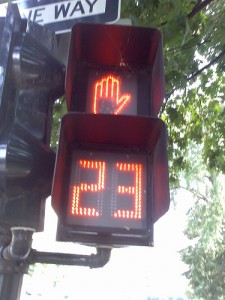 People in Matt Yglesias‘ neighborhood have petitioned to increase the amount of time pedestrians get to cross New York Avenue at 5th St. NW from 20 to 45 seconds and they’ve been rejected. The rationale:
People in Matt Yglesias‘ neighborhood have petitioned to increase the amount of time pedestrians get to cross New York Avenue at 5th St. NW from 20 to 45 seconds and they’ve been rejected. The rationale:
DDOT is concerned that changing the walk time at this intersection may negatively impact pedestrian safety at this intersection further, in addition to negatively affecting traffic flow. We would like to share these two impacts with you.
Signal and pedestrian timing at this intersection is set as a standardized actuated signal, which is in agreement with the Manual of Uniform Traffic Control Devices (MUTCD). Further, this standard is consistent with the requirements of Americans with Disabilities Act. The MUTCD is the national standard for traffic signals and other infrastructure matters. In following these standards, the signal is designed to display visible countdown time only during the “do not walk” flashing time. Therefore, the viewable walk time on this signal is only 20 seconds. The total time for pedestrians to cross however, is 30 seconds. The breakdown for the signal’s walk time is as follows:
5 seconds of walk time as background time (not seen)
3 seconds of yellow as background time (not seen)
2 seconds of all red signal as background time (not seen)
20 seconds visible walk time (viewable)
Although ten seconds are unseen, 20 seconds are still present for pedestrians to cross. Thirty full seconds are documented as walk time in this signal.
If the signal is changed, even in a small increment, the total cycle signal length of the entire intersection will be altered and the allowable green time for traffic will be reduced. This could result in additional traffic delays further along New York Avenue. An overflow of traffic may adversely affect pedestrian safety as gridlocked traffic could occur through the intersections and crosswalks.
Matt summarizes: “beneath all the verbiage in their reply, what they’re saying comes down to the basic point that if you gave pedestrians more time to cross New York Avenue, that would slow New York Avenue traffic.” Readers can decide for themselves whether that’s a fair reading.
This, though, strikes me as odd:
Management of a city involves hundreds—if not thousands—of these little decisions. Do we do what’s best for people on foot, or what’s best for people in cars? Since tilting policy on behalf of pedestrians rather than drivers is distributively progressive—the poor are less likely than the rich to own cars, especially in a place like DC—and environmentally beneficially and good for public health, I don’t see it as a very difficult choice. But not only did DDOT not make the pro-pedestrian choice, they don’t even really seem to see it as a choice. They just take it for granted that their job is to maximize the flow of vehicle traffic along New York Avenue. The rest of us just live in the neighborhood.
First, people are people regardless of whether they’re in a car or walking at any given moment. So, the question is “what’s best for people,” period.
Yes, there are tradeoffs here but they’re more complicated than who has to wait longer at the intersection. DDOT is right that making cars wait longer results in backups, which create ripple effects. Further, 30 seconds is more than long enough to cross the street.
Most of us who are driving are doing so because we’re going a long way — usually between DC and its suburbs but sometimes between far-flung parts of the District — not because we’re too lazy to walk. Driving in DC is sufficiently inconvenient as it is that most of us will walk for many blocks rather than attempt to drive.
Because cars tend to move faster than pedestrians — although not always given DC traffic — there’s more likely to be a number of cars ready to go through an intersection at a given time than there is to be a queue of people waiting to cross. Cars stopped at a light have to wait for the cars in front of them, one by one, to move through a light before they can do so themselves; this is known as the “accordion effect.” Contrariwise, a gaggle of pedestrians waiting at a light can travel as a pack across the road in smart fashion, clearing the pent-up demand within the 30 seconds allotted without problem. Indeed, I’ve never not made it across the street in one iteration of the light in pedestrian mode whereas I frequently have to wait through multiple iterations as a driver.
It’s worth noting, too, that the cultures of driving and walking are different. I frequently drive into DC. Once there, I become a pedestrian. When I’m driving, I invariably stop for red lights and stay stopped for the duration of said lights. When I’m walking, I stop at Don’t Walk signs and promptly cross as soon as I deem it safe to do so. The vast majority of drivers and walkers act in this manner. That means that longer lights are a far greater nuisance to drivers than pedestrians.
Finally, if one’s desire is to reduce the environmental impact of automobiles, creating longer periods of idling time is decidedly not the solution.
Photo by Flickr user Sara Richards under Creative Commons license.

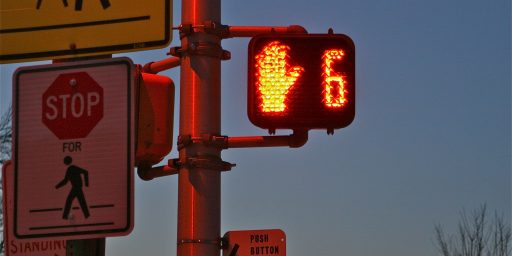
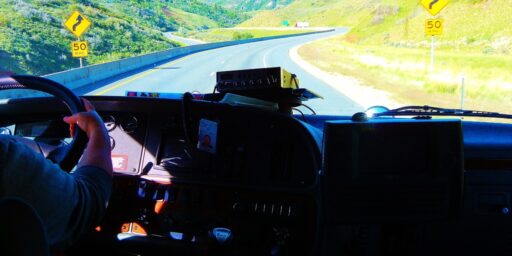
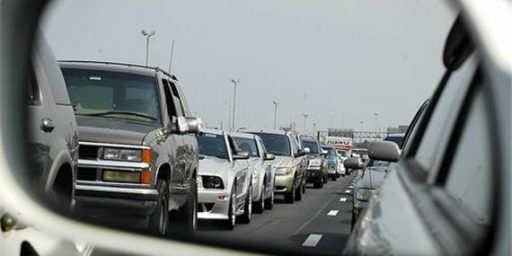
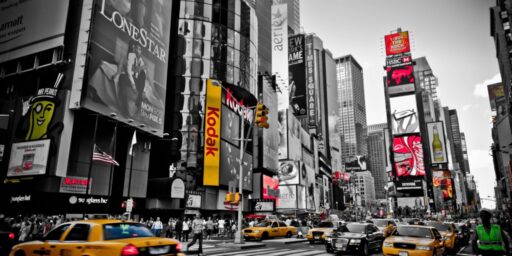
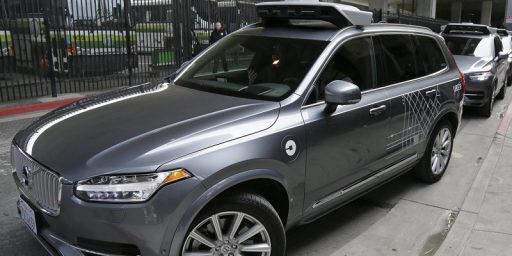
Finally, if one’s desire is to reduce the environmental impact of automobiles, creating longer periods of idling time is decidedly not the solution.
I think you may find that Yglesias has a different solution in mind: eliminate private ownership of cars. Fits in with his theory that the masses should be content with government-mandated apartment living.
Given the subject matter, this seems an odd choice of wording.
Quoting Young Mr. Yglesias is so unfair.
The solution to crosswalks: Jaywalking! It’s safer too.
Why does Matt hate the environment?
As for jaywalking in DC, I agree it is safer. Had a fellow graduate student get hit by a car in a crosswalk with the light in her favor. DC drivers are horrible drivers when it comes to pedestrians.
I think that’s true in any big city. Much worse in Manhattan than DC. It’s frustrating for both when a car has a green light but can’t make a right turn because of pedestrians lollygagging their way across. The driver has to either nose his way in or not cross, as there will never be a time with no pedestrians.
Jaywalking pedestrians are a problem, too. I turn, on a protected green arrow no less, from 14th St on to K St most days. Because I have to turn right on 15th, I actually have to turn into one of those inside protected lanes. Invariably, idiot pedestrians will be streaming across on their red light, oblivious of cars. And most drivers will wait around like idiots for them to cross, thus backing up traffic behind them.
Los Angeles isn’t bad. When I went from L.A. to D.C. it was a big change pedestrian/traffic wise. I didn’t even like driving in D.C. whereas I have no problem in Los Angeles. Must be a cultural thing.
Yglesias’ comment about maximizing traffic flow on New York Ave is also misleading. That is done simply enough, disallow cross walks and pedestrian cross traffic.
And his argument is one of, “I want to be able to cross the street with greater ease, so I want increased gridlock in my neighborhood.”
Moreover, what we also have is that Yglesias feels his interests and those of his neighbors are of a higher priority than those of people travelling the public streets through his neighborhood. Instead of viewing it as an issue of trade-offs Matthew has recast it as an “us vs. them” issue and one where his rights are paramount because he lives there and that we are talking about public roads be damned.
Yet another fantastic showing by Mr. Yglesias.
I don’t know about DC or Virginia, but here in MO, the pedestrian ALWAYS has the right of way.
I once saw an old (75-80) woman get run over by an *sshole in a hurry. She had the light, but he was trying to beat the yellow (she was not going to beat the red) and he cut his left turn a little too close… I still remember his face (30 yrs ago) as he looked around just before he took off. Fortunately she had only a broken arm (hip apparently was fine).
Amazingly enough, all traffic came to a complete halt (except for one guy who tried to chase the *sshole down) I sat with her in the middle of a very busy intersection for about 5 mins (it may have been less) until EMS arrived. The entire time, everyone was very careful as they drove around us.
While I don’t like driving in DC, you could not pay me to drive in LA. NY? Fuhgedaboutit!
Then again, I have no problem at all driving in Mexico. (not for the faint of heart) But then, “I’m a freak”
It’s considered bad form to run over pedestrians anywhere but at lighted intersections, pedestrians are expected to yield to cars when they have the Don’t Walk.
I’ve only driven in LA a little bit but find it to be essentially suburban, vice NYC and DC which are urban. LA has traffic jams on the major highways, to be sure, but there don’t tend to be a lot of pedestrian crossings there.
Yeah, running over old people on walkers is pretty much frowned upon no matter where you go. And while they are “expected to yield to cars “ in any # of situations, the law still says they have the right of way. The fact is, that a 3500 lb vehicle usually wins these arguments, something they seem to understand intuitively in Mexico.
When I grew up in LA (so many years ago, you don’t want to know), if one stepped off the curb in the middle of the street, the cars would stop for you and allow you to cross. Of course, that was a long time ago, in a valley far, far away.
I always find it funny when people run across the street as if when the light turns green the cars will just mow into them if they haven’t already crossed.
I do try to step lively to get across so that those in cars wishing to turn can do so.
I always find it funny when self-identified conservatives who profess to be so much more literate about economics (especially incentives) get traffic completely wrong.
If you make it easier to drive, more driving will occur (at the margins). If you make it harder to drive, less driving will occur (at the margins). Where does all interesting economics occur? (at the margins).
Yes, if you improve traffic flow for cars, it’s likely that, for a little while, there will be less idling. For a little while. Then, the traffic will adjust to the new conditions (unless you’re somewhere like Detroit), and you’re back to effective square one.
Likewise with the ‘OMG, cars will suffer and there will be gridlock’ argument. In an area with good transit and reasonable pedestrian accomodations, a lot of that demand for driving is elastic, despite what people say.
I’d venture to say that most people on DC’s roads are, like me, people for whom driving is the only reasonable option. DC has decent public transit for people who live within certain parts of the city and even certain key suburbs. Otherwise, you have to drive to get to public transit, rendering it useless.
Again, James, interesting activity occurs at the margins. There are obviously some people in DC who could choose to switch, given how driving goes up and down in response to changing conditions like gas prices.
And driving to a Metro station to get into the city is hardly useless.
It is if it takes a substantial amount of time to get there, one then has to pay a significant amount to park, and then it’s still inconveniently slow. Public transit has to be more convenient than that to be attractive to any but the very poor.
or driving has to be less convenient or more expensive than it is now. At some point gridlock will render transit more attractive.
But that would be a bad thing, right? The goal, one should think, is getting people from point A to point B the most efficient way possible.
It’s one thing to make transit convenient and attractive. It’s quite another to neglect the other infrastructure to make transit the least bad remaining alternative.
Why not, instead, figure out how to make rail faster, more convenient, and more accessible?
I’m not arguing for that outcome, just pointing out another way that public transit can become more attractive. At some point we will not be able to build more roads and will not be able to make the everyone drives a car to work model end up in anything other than gridlock on a scale that makes even current rail transit look better by comparison. Given American car culture I think that the gridlock would have to result in considerably greater time and money over public transit for there to be a meaningful switch.
Depending on where you want to go in the Bay Area it seems to be nearly a break even on both. You do end up with a bit less flexibility, but for me that is made up for by not having to deal with traffic or parking. I understand that is also the case in Boston, Chicago, and some other metro areas as well. I haven’t dealt with those transit systems enough to judge though.
I find it amazing how many people who profess to be so much more economically literate than their adversaries insist that we should just ‘make transit better’. The competition is what matters – Pepsi could improve by 10%, but if Coke improves by 15%, are they going to pick up any customers?
Likewise, if we keep spending most of our time and money making the ‘free’ competition better, the transit alternative will never catch up. Unfortunately, even the stimulus plan perpetuates this disastrous misallocation of tax dollars.
The margins, say you? So the interesting traffic will all be driving on the sidewalks?